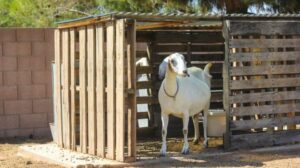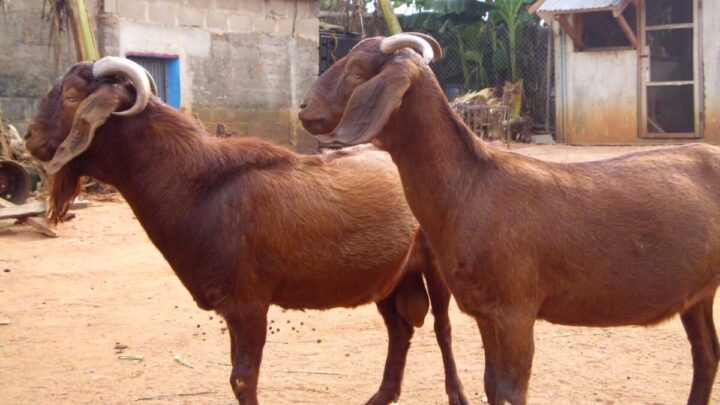Last updated on May 12, 2025
Goat farming is a profitable venture in Nigeria, but without proper housing, you risk losing your herd to harsh weather, diseases, and predators. Whether you’re a beginner or a seasoned farmer, building the right goat house is essential for keeping your animals safe, healthy, and productive.
In this guide, I’ll show you how to construct an effective and affordable goat shelter using materials readily available in Nigeria. You’ll also learn about the best housing designs, ventilation tips, flooring options, and cost-effective construction methods.
Why Proper Goat Housing Matters
A well-structured goat house isn’t just about giving your animals a place to sleep—it plays a crucial role in:
- Protecting against extreme weather – Goats are vulnerable to Nigeria’s hot climate and heavy rains.
- Preventing diseases – A poorly built house can lead to infections, foot rot, and respiratory illnesses.
- Reducing stress and boosting productivity – Comfortable goats grow faster and produce more milk or meat.
- Keeping predators away – Snakes, wild dogs, and thieves are a real threat to free-range goats.
Key Considerations for Goat Housing in Nigeria
Before you start building, here are the most important factors to consider:
- Location: Choose a high, well-drained area to prevent flooding and dampness. Avoid swampy areas!
- Ventilation: Goats hate stuffy spaces. Ensure good airflow to keep the house dry and odor-free.
- Materials: Use cheap but durable materials like bamboo, wood, mud bricks, or corrugated iron sheets.
- Flooring: Raised wooden floors are best to keep goats dry and clean. Avoid cement floors—they get too cold.
- Roofing: A sloped roof helps rainwater drain off quickly, preventing leaks.
- Space per goat: Adult goats need at least 1.5 – 2 square meters per animal. Overcrowding leads to stress and disease.
- Security: Strong doors and fencing protect against thieves and predators.
Best Goat House Designs for Nigeria
1. Raised Wooden House (Recommended for Small-Scale Farmers)
- Best for: Small farms and backyard goat keepers.
- Pros: Keeps goats dry, reduces disease risks, easy to clean.
- Materials: Wood, bamboo, or planks with a wire-mesh floor.
- Design: Raised about 2-3 feet off the ground with gaps for urine drainage.
2. Mud Brick House (Low-Cost Option)
- Best for: Farmers on a tight budget.
- Pros: Cheap, cool in hot weather.
- Cons: Can get damp and attract pests if not built properly.
- Design: Use locally made mud bricks with a thatched or iron-sheet roof. Ensure proper ventilation.
3. Semi-Concrete House (For Large-Scale Farms)
- Best for: Commercial goat farms.
- Pros: Durable, easy to maintain.
- Cons: Higher cost.
- Design: Use a combination of concrete pillars and wooden floors for a strong, long-lasting structure.
Cost of Building a Goat House in Nigeria
The cost depends on the size, materials, and location, but here’s a rough estimate:
| Goat House Type | Cost Estimate (NGN) | Capacity |
| Small Wooden House (5-10 goats) | ₦50,000 – ₦100,000 | 5-10 goats |
| Mud Brick House (10-20 goats) | ₦80,000 – ₦150,000 | 10-20 goats |
| Semi-Concrete House (50+ goats) | ₦250,000 – ₦500,000 | 50+ goats |
Step-by-Step Guide to Building a Simple Goat House
Step 1: Choose a Dry, Elevated Location
- Avoid swampy areas to prevent hoof diseases.
- The land should have proper drainage.
Step 2: Gather Your Materials
You can use wood, bamboo, palm fronds, or iron sheets—whatever is available and affordable.
Step 3: Build the Foundation
- For raised houses, use strong wooden poles.
- For ground-level houses, lay mud bricks and compact the floor with dry sand.
Step 4: Construct the Walls
- Use wooden planks, bamboo, or bricks with gaps for ventilation.
- If using mud bricks, make small windows to allow airflow.
Step 5: Add a Strong Roof
- A slanted iron-sheet or thatched roof works best.
- Ensure proper drainage to prevent leaks.
Step 6: Install Proper Flooring
- Best option: Wooden slatted floors (raised houses).
- If using ground floors, cover with dry sand and straw to keep it dry.
Step 7: Secure the House
- Build a strong door and fence the area to keep predators out.
- If possible, install a simple lock to prevent theft.
Maintaining a Healthy Goat House
- Clean the house daily – Remove waste and leftover food.
- Disinfect regularly – Use lime powder to prevent pests.
- Keep it dry – Wet bedding causes diseases.
- Separate sick goats – To prevent infections from spreading.
Conclusion
Building the perfect goat shelter in Nigeria doesn’t have to break the bank. Whether you choose a raised wooden house, a mud-brick structure, or a semi-concrete shelter, the key is to keep it dry, well-ventilated, and secure.
By following the steps above, you can create a cost-effective, durable, and comfortable home for your goats—boosting their health, productivity, and ultimately, your farm’s profitability.
Got any questions? Let me know in the comments!


